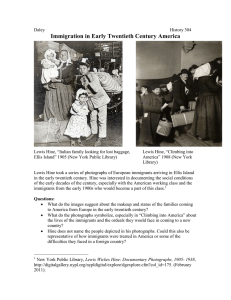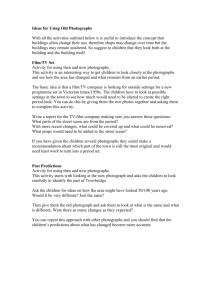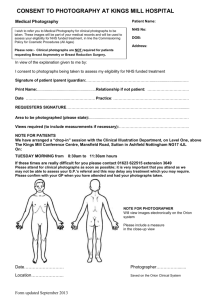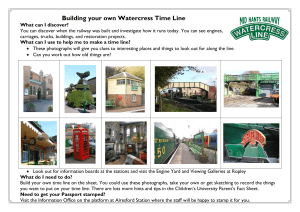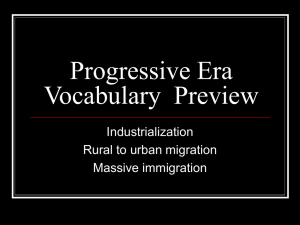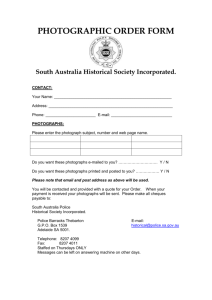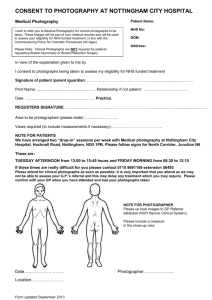Lewis Hine
advertisement
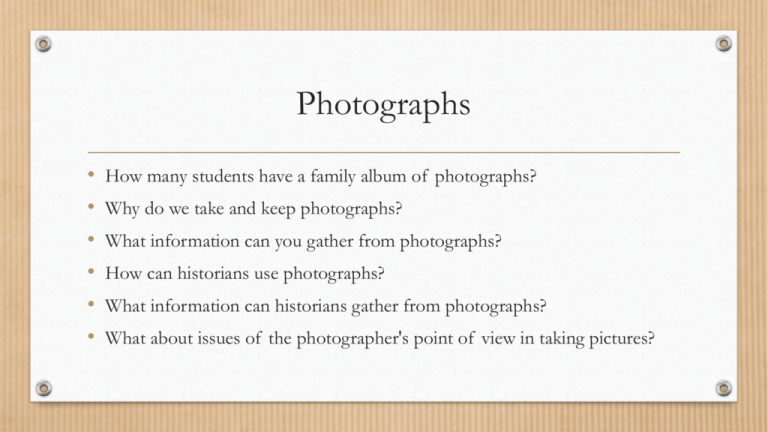
Photographs • • • • • • How many students have a family album of photographs? Why do we take and keep photographs? What information can you gather from photographs? How can historians use photographs? What information can historians gather from photographs? What about issues of the photographer's point of view in taking pictures? Lewis Hine Documentation of Child Labor in America "There is work that profits children, and there is work that brings profit only to employers. The object of employing children is not to train them, but to get high profits from their work." -- Lewis Hine, 1908 The Demand for Labor Grows… • Factory wages were so low that children often had to work to help support their families • Children under the age of 15 who worked in industrial jobs for wages climbed from 1.5 million in 1890 to 2 million in 1910. • Businesses liked to hire children • worked in unskilled jobs for lower wages than adults • small hands made them more adept at handling small parts and tools • Children were part of the family economy • Immigrants and rural migrants sent their children to work, or worked alongside them Child Laborers Barely Experience Their Youth • Going to school to prepare for a better future was an opportunity these underage workers rarely enjoyed. • As children worked in industrial settings, they began to develop serious health problems. • Many child laborers were underweight • Some suffered from stunted growth and curvature of the spine • Developed diseases related to their work environment • such as tuberculosis and bronchitis for those who worked in coal mines or cotton mills. • Faced high accident rates due to physical and mental fatigue caused by hard work and long hours “Child Slavery” • Early 1900s many Americans were demanding an end to it. • Long hours of work deprived children of the opportunity of an education to prepare themselves for a better future. • Child labor condemned them to a future of illiteracy, poverty, and continuing misery. National Child Labor Committee • In 1904 a group of progressive reformers formed an organization whose goal was the abolition of child labor. • Hired teams of investigators to gather evidence of children working in harsh conditions and then organized exhibitions with photographs and statistics to dramatize the plight of these children • Resulted in the establishment in 1912 of the Children's Bureau as a federal information clearinghouse • In 1913 the Children's Bureau was transferred to the Department of Labor Lewis Hine • A New York City schoolteacher and photographer • Believed that a picture could tell a powerful story • He felt so strongly about the abuse of children as workers that he quit his teaching job and became an investigative photographer for the National Child Labor Committee. • Traveled around the country photographing the working conditions of children in all types of industries • coal mines, meatpacking houses, textile mills, and canneries. • children working in the streets as shoe shiners, newsboys, and hawkers His Photographs • Tricked his way into factories to take the pictures that factory managers did not want the public to see • Careful to document every photograph with precise facts and figures • To obtain captions for his pictures • interviewed the children on some pretext and then scribbled his notes with his hand hidden inside his pocket • he was "double-sure that my photo data was 100% pure--no retouching or fakery of any kind." • defined a good photograph as "a reproduction of impressions made upon the photographer which he desires to repeat to others." • realized his photographs were subjective, he described his work as "photointerpretation." Lewis Hine Lewis Hine died in poverty, neglected by all but a few. His reputation continued to grow, however, and now he is recognized as a master American photographer. His photographs remind us what it was like to be a child and to labor like an adult at a time when labor was harsher than it is now. Hine's images of working children stirred America's conscience and helped change the nation's labor laws. Through his exercise of free speech and freedom of the press, Lewis Hine made a difference in the lives of American workers and, most importantly, American children. Write all of the things down that you just saw… Now…look more closely… Has anything that you see in the photograph now changed from the first time you viewed it? Independent Photo Analysis Assignment • Part I • The History Place link on my staff webpage • Select a photograph • Conduct the Photo Analysis Procedure and complete the questions • Part II • Choose from 3 Options: • Story (1 page) • Diary Entry (1 page) • Multimedia Presentation • The evaluation will be based on your understanding of child labor issues at the turn of the century. Part II Options (choose 1) • Create a story around the photograph that addresses the issues of child labor • Include safety on the job, inability to get an education, health hazards in the work environment, general health of young children, the movement to abolish child labor, general living conditions of the era • Create a diary entry for a person in one of the photographs. • Describe in detail the person's workday and explain his or her reasons for working and feelings about the job • Create a multimedia presentation • Identify 10 photographs that you feel best tell the story of child labor during the early 1900s • Pictures must be explained and defended as your choice
